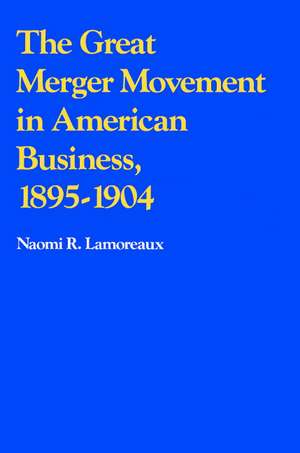The Great Merger Movement in American Business, 1895–1904
Autor Naomi R. Lamoreauxen Limba Engleză Paperback – 28 apr 1988
Preț: 202.74 lei
Nou
Puncte Express: 304
Preț estimativ în valută:
38.79€ • 40.50$ • 32.11£
38.79€ • 40.50$ • 32.11£
Carte tipărită la comandă
Livrare economică 04-18 aprilie
Preluare comenzi: 021 569.72.76
Specificații
ISBN-13: 9780521357654
ISBN-10: 0521357659
Pagini: 224
Dimensiuni: 158 x 228 x 14 mm
Greutate: 0.35 kg
Editura: Cambridge University Press
Colecția Cambridge University Press
Locul publicării:New York, United States
ISBN-10: 0521357659
Pagini: 224
Dimensiuni: 158 x 228 x 14 mm
Greutate: 0.35 kg
Editura: Cambridge University Press
Colecția Cambridge University Press
Locul publicării:New York, United States
Cuprins
Acknowledgments; List of tables and figures; 1. Introduction; 2. Product differentiation, mass production, and the urge to merge: competitive strategies and collusion in the late nineteenth century; 3. High fixed costs and rapid expansion: a model of price warfare and two examples; 4. Quantitative and qualitative evidence on the great merger movement; 5. What changed? the impact of consolidations on competitive behaviour; 6. The great merger movement and antitrust policy; 7. Conclusion; Bibliographical essay; Index.
Recenzii
Review of the paperback: 'During the decade from 1895 to 1904, more than 1800 manufacturing firms merged into 157 consolidated corporations, many of which in turn dominated their industries and became some of the best-known companies in the United States. In the three generations since, capable scholars in many disciplines have offered a variety of explanations. Now, in a clearly written, sophisticated, and remarkably concise book, Naomi R. Lamoreaux presents a synthesis and bold critique of that scholarship, together with strikingly original insights of her own.' Journal of American History
Review of the paperback: 'Professor Lamoreaux has explored the great merger wave of turn-of-the-century America as an event produced by special circumstances that had serious implications for the health of the American business system nearly a century later. We can hope that she will continue to apply her enormous talent to a further explication of these implications.' Reviews in American History
Review of the paperback: 'In this book Naomi Lamoreaux directs our focus from the role of vertical integration and the managerial 'resolution' in the emergence of the large, modern corporation emphasized by Alfred Chandler back to where it had been initially, on the never-equalled wave of horizontal consolidations in manufacturing between 1895 and 1904. The causes and effects of this merger wave, which permanently altered the structure of the American economy, are important and difficult questions, usually sidestepped by new economic historians. Lamoreaux skillfully analyzes them with an imaginative blend of business history and cliometrics … I found the book extremely interesting and suggestive and profited greatly from it. It is well written, clearly argued, and accessible to general historians as well as economists. It should have great impact in focusing attention on this important period of consolidating.' Journal of Economic History
Review of the paperback: 'This book is a model of good economic history and of good scholarship. Professor Lamoreaux has beautifully balanced a thorough reading of the history of the period with a plausible economic theory of the events and presented them in a readable and persuasive manner. I am certain that this will become the standard work on the great merger wave of the late nineteenth century.' Journal of Economic Literature
Review of the paperback: 'Professor Lamoreaux has explored the great merger wave of turn-of-the-century America as an event produced by special circumstances that had serious implications for the health of the American business system nearly a century later. We can hope that she will continue to apply her enormous talent to a further explication of these implications.' Reviews in American History
Review of the paperback: 'In this book Naomi Lamoreaux directs our focus from the role of vertical integration and the managerial 'resolution' in the emergence of the large, modern corporation emphasized by Alfred Chandler back to where it had been initially, on the never-equalled wave of horizontal consolidations in manufacturing between 1895 and 1904. The causes and effects of this merger wave, which permanently altered the structure of the American economy, are important and difficult questions, usually sidestepped by new economic historians. Lamoreaux skillfully analyzes them with an imaginative blend of business history and cliometrics … I found the book extremely interesting and suggestive and profited greatly from it. It is well written, clearly argued, and accessible to general historians as well as economists. It should have great impact in focusing attention on this important period of consolidating.' Journal of Economic History
Review of the paperback: 'This book is a model of good economic history and of good scholarship. Professor Lamoreaux has beautifully balanced a thorough reading of the history of the period with a plausible economic theory of the events and presented them in a readable and persuasive manner. I am certain that this will become the standard work on the great merger wave of the late nineteenth century.' Journal of Economic Literature











